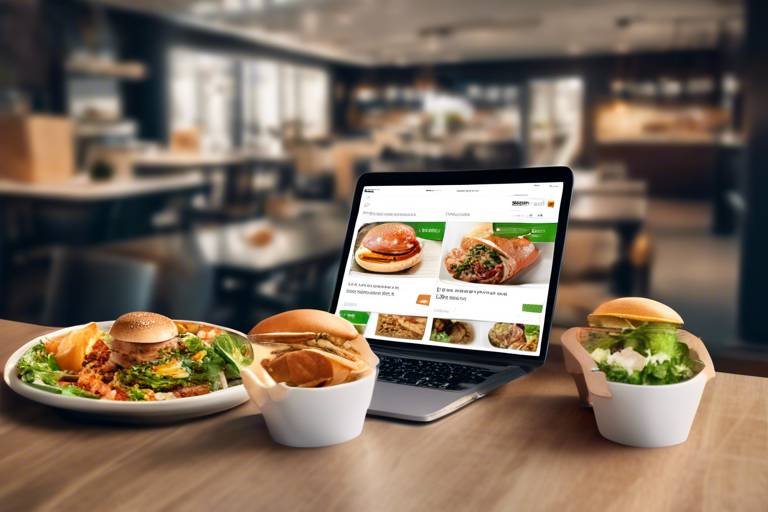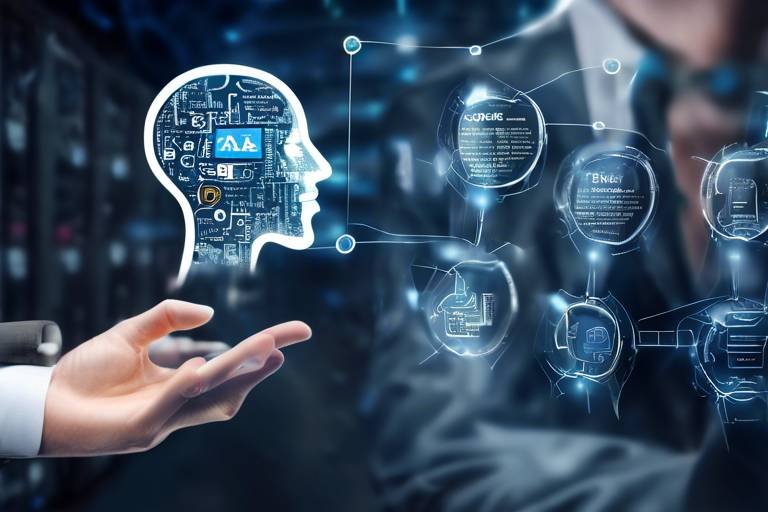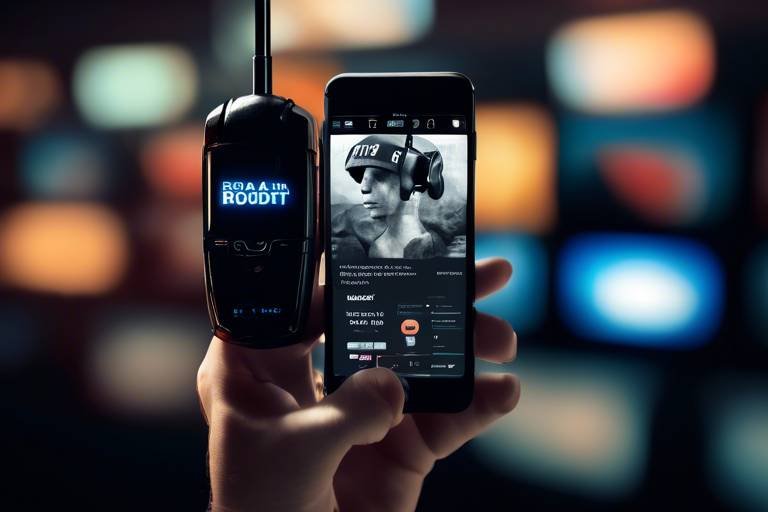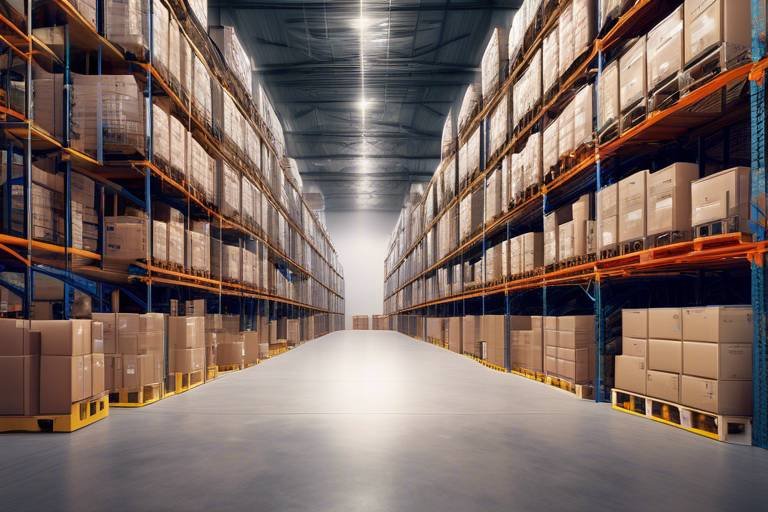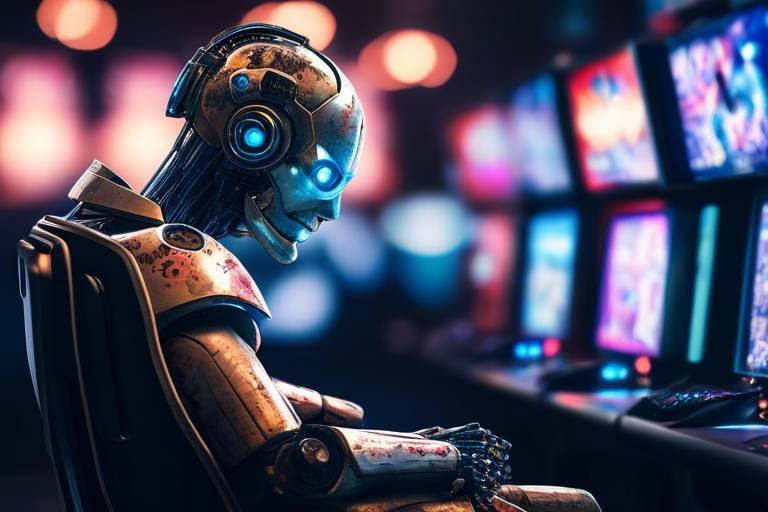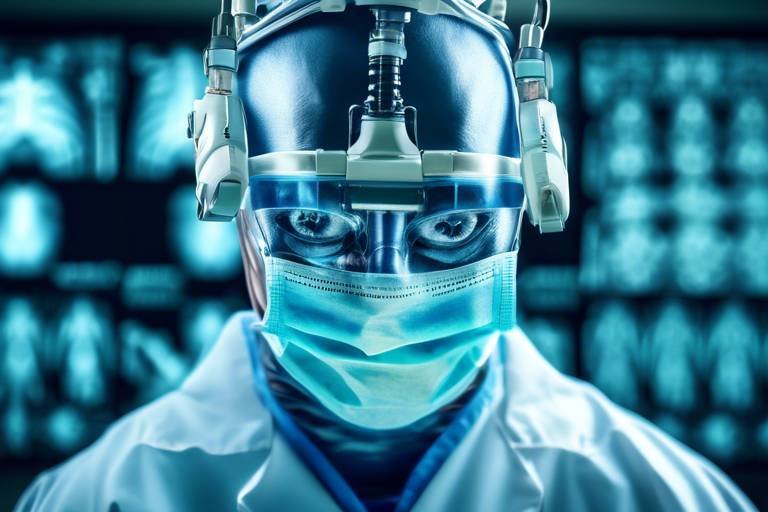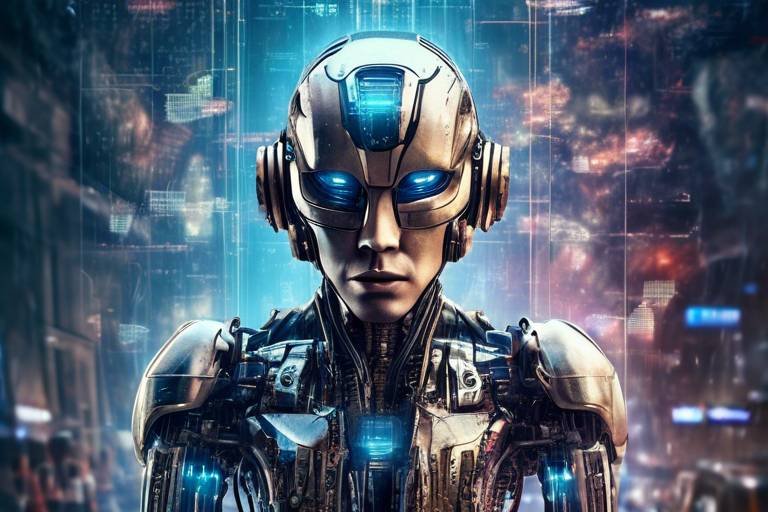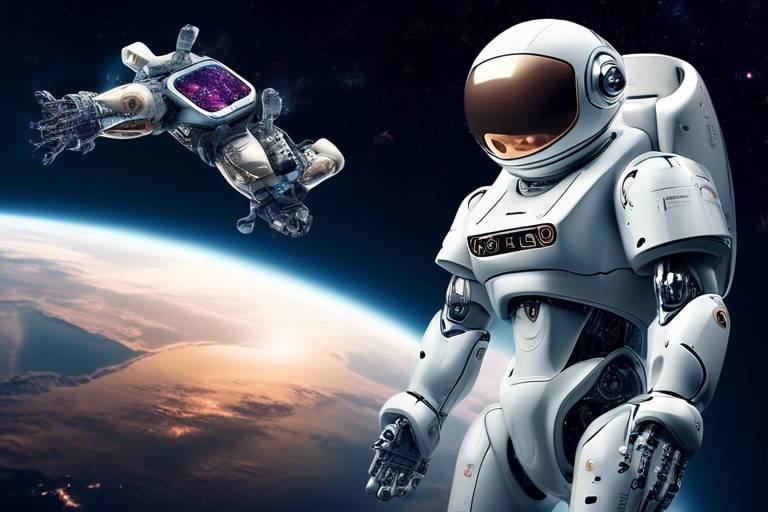Impact of AI on Sector of Food Delivery Services
The food delivery industry has undergone a seismic shift in recent years, largely fueled by the integration of artificial intelligence (AI). Imagine a world where your favorite meal arrives at your doorstep not just quickly, but also tailored to your unique tastes and preferences. This is not a distant dream; it’s the reality that AI is creating today. From streamlining operations to enhancing customer experiences, AI is revolutionizing how food delivery services operate. The impact is profound, as businesses leverage AI technologies to not only meet but exceed customer expectations.
One of the most significant advantages AI brings to the table is its ability to analyze vast amounts of data in real-time. This capability allows food delivery services to make informed decisions that enhance efficiency and improve service quality. For instance, by predicting demand patterns, AI can help companies manage their inventory better, ensuring that popular items are always available while minimizing waste. This not only saves money but also contributes to a more sustainable business model, which is increasingly important to today's environmentally conscious consumers.
Furthermore, AI facilitates personalized customer experiences. By analyzing customer data, delivery platforms can make tailored recommendations that cater to individual preferences, dietary restrictions, and even past orders. This level of personalization fosters a sense of loyalty among customers, as they feel understood and valued. Think about it: when a service knows exactly what you like and delivers it seamlessly, it’s hard not to come back for more.
The benefits of AI extend beyond mere convenience; they also encompass dynamic pricing strategies. AI systems can adjust prices based on various factors such as demand fluctuations, weather conditions, and local events. For example, during a sudden rainstorm, the demand for food delivery might spike, allowing companies to implement higher prices. This flexibility not only maximizes revenue but also helps maintain competitive pricing for consumers, ensuring that everyone can still enjoy their favorite meals without breaking the bank.
Another critical area where AI shines is in real-time analytics. Delivery services can monitor performance metrics and customer feedback instantaneously, allowing for quick adjustments to improve service quality. If a particular dish receives negative reviews, AI can flag this issue for immediate attention, enabling the restaurant to address it before it affects more customers. This proactive approach to customer feedback integration ensures that companies remain agile and responsive to the ever-evolving preferences of their clientele.
Beyond improving the customer experience, AI also plays a crucial role in delivery route optimization. By analyzing traffic patterns and other variables, AI algorithms can determine the fastest and most efficient routes for delivery personnel. This not only minimizes delivery times but also reduces fuel consumption, leading to lower operational costs. In a world where efficiency is paramount, these AI-driven solutions are invaluable for food delivery services looking to stay competitive.
In addition to enhancing operational efficiency, AI technologies are also contributing to enhanced safety measures. The implementation of contactless delivery options has become a game-changer, especially in the wake of global health concerns. Customers can now enjoy their meals with peace of mind, knowing that hygiene standards are being upheld. Moreover, real-time tracking provides transparency for both customers and delivery personnel, ensuring that everyone is informed throughout the delivery process.
The rise of automated delivery systems, such as drones and robots, showcases how AI is revolutionizing the logistics of food delivery. These innovations not only make the delivery process faster but also open up new avenues for efficiency that were previously unimaginable. Picture a drone zipping through the sky, delivering your lunch while you’re still at your desk—this is the future that AI is paving the way for.
As we look ahead, emerging trends like AI-driven ghost kitchens and predictive analytics will undoubtedly shape the future landscape of food delivery. These advancements promise to create new opportunities for innovation and growth in the sector, pushing the boundaries of what we thought was possible. The integration of AI into food delivery services is not just a trend; it’s a fundamental shift that will redefine how we experience food delivery in the years to come.
- How is AI used in food delivery services? AI is used to streamline order management, personalize customer experiences, optimize delivery routes, and enhance safety measures.
- What are the benefits of AI in food delivery? Benefits include improved efficiency, faster service, personalized recommendations, and enhanced safety protocols.
- Will AI replace human delivery drivers? While AI technologies like drones and robots are emerging, human delivery drivers will likely coexist with these systems for the foreseeable future.

AI-Powered Order Management
In the fast-paced world of food delivery, efficiency is key, and that's where comes into play. Imagine a system so intelligent that it can predict how many pizzas will be ordered on a rainy Friday night or determine the best route for a delivery based on real-time traffic data. This is not science fiction; it’s the reality of how artificial intelligence is transforming the food delivery landscape. By utilizing sophisticated algorithms, AI streamlines the entire order processing system, which significantly enhances the speed and accuracy of service.
One of the most remarkable features of AI in order management is its ability to predict demand. By analyzing historical data and current trends, AI can forecast which dishes will be popular at different times. For instance, if a big game is on, AI can suggest that a restaurant prepare more wings and nachos, ensuring they are ready to meet customer demand. This not only reduces wait times but also minimizes food waste, creating a win-win situation for both businesses and customers.
Another crucial aspect is optimizing delivery routes. Traditional methods of route planning often lead to delays and increased fuel consumption. However, AI takes into account various factors such as traffic conditions, weather, and even local events, to determine the most efficient delivery paths. This means that drivers spend less time on the road, and customers receive their meals faster. The result? A more satisfied clientele and lower operational costs for delivery services.
Moreover, AI plays a vital role in inventory management. By continuously monitoring stock levels and predicting future needs, AI can alert restaurants when they need to restock ingredients, ensuring that they never run out of essential items. This proactive approach not only keeps operations running smoothly but also enhances the overall customer experience by preventing menu items from being unavailable.
To illustrate the impact of AI-powered order management, consider the following table that highlights the benefits:
| Feature | Benefit |
|---|---|
| Demand Prediction | Reduces wait times and food waste |
| Route Optimization | Enhances delivery speed and reduces costs |
| Inventory Management | Ensures availability of menu items |
In conclusion, AI-powered order management is not just a trend; it's a necessity for food delivery services aiming to thrive in a competitive market. By harnessing the power of artificial intelligence, these services can achieve unprecedented levels of efficiency, ultimately leading to a better experience for both customers and businesses alike. As we continue to embrace technology, the future of food delivery looks not only promising but also incredibly exciting.

Personalized Customer Experience
In today's fast-paced world, where convenience is key, personalized customer experiences have become a game-changer for food delivery services. Imagine ordering your favorite pizza and receiving a tailored suggestion for a new dessert that perfectly complements your meal. This is not just a dream; it’s a reality made possible by artificial intelligence (AI). By analyzing vast amounts of data, AI can understand individual preferences, dietary restrictions, and even previous orders. This means that every time you order, the service can present you with options that truly resonate with your tastes.
But how does this work in practice? AI algorithms analyze customer behavior and feedback to create a profile for each user. This profile includes information such as:
- Your favorite cuisines
- Allergies or dietary preferences
- Ordering habits, like time of day and frequency
With this data, food delivery platforms can offer personalized recommendations that not only save you time but also enhance your overall experience. For instance, if you frequently order vegan dishes, the platform might highlight new vegan restaurants or dishes that have just been added to their menu. This level of customization not only makes the ordering process smoother but also fosters a sense of loyalty and satisfaction among customers.
Moreover, AI can help in predicting what you might want even before you know it yourself! By analyzing trends and seasonality, AI can suggest meals that fit the current weather or local events. For example, on a rainy day, you might receive recommendations for warm soups or comforting casseroles. This predictive capability transforms the food delivery experience from a mere transaction into a delightful culinary journey.
To further enhance customer satisfaction, many food delivery services are integrating feedback mechanisms into their platforms. This means that after every order, you might receive a quick survey asking about your experience. AI can then analyze this feedback to refine its recommendations continually. If many customers express a desire for healthier options, the service can adjust its offerings accordingly, ensuring that it stays relevant and in tune with consumer needs.
In conclusion, the integration of AI into food delivery services is not just about efficiency; it’s about creating a that resonates with individual preferences and enhances satisfaction. As technology continues to evolve, we can expect even more innovative approaches to catering to our tastes, making every meal a uniquely tailored experience.
- How does AI personalize my food delivery experience?
AI analyzes your past orders, preferences, and feedback to suggest meals that match your tastes. - Can AI understand dietary restrictions?
Yes, AI systems can be programmed to recognize dietary restrictions and allergies, ensuring safe recommendations. - Will I receive suggestions for new restaurants?
Absolutely! AI can highlight new or trending restaurants based on your preferences and ordering history. - How does customer feedback impact recommendations?
AI uses customer feedback to refine its algorithms, ensuring that recommendations evolve with consumer preferences.

Dynamic Pricing Strategies
In the ever-evolving world of food delivery services, have emerged as a game-changer. Imagine a bustling city on a rainy Friday night. The demand for hot meals skyrockets, and so does the value of your delivery service. This is where AI steps in, using sophisticated algorithms to adjust prices in real-time based on various factors. These factors can include demand fluctuations, weather conditions, and even local events. Just like how airlines adjust ticket prices based on availability and demand, food delivery services can now optimize their pricing to maximize revenue while still offering competitive rates to consumers.
The beauty of dynamic pricing lies in its ability to create a win-win situation. For consumers, it means they can snag a great deal during off-peak hours, while businesses can capitalize on high-demand periods. For instance, if a major sports event is happening nearby, AI can increase prices slightly to reflect the surge in demand for food delivery. This not only boosts revenue but also helps manage the inflow of orders, ensuring that the delivery personnel are not overwhelmed.
To illustrate the effectiveness of dynamic pricing, consider the following table that highlights how different factors can influence pricing adjustments in food delivery services:
| Factor | Impact on Pricing | Example |
|---|---|---|
| Demand Fluctuations | Prices increase during peak hours | Lunch rush from 12 PM to 2 PM |
| Weather Conditions | Higher prices during inclement weather | Rainy days leading to increased delivery orders |
| Local Events | Prices rise during concerts or festivals | Food delivery during a music festival |
Moreover, AI-driven dynamic pricing not only adjusts prices based on external factors but also takes into account customer behavior. For example, if a customer frequently orders sushi on Friday nights, the system might offer them a special discount during that time, encouraging loyalty and repeat business. This personalized approach not only enhances customer satisfaction but also fosters a sense of belonging, making them feel valued as a customer.
In conclusion, dynamic pricing strategies powered by AI are revolutionizing the food delivery sector. By leveraging real-time data, companies can make informed decisions that benefit both the business and the consumer. As we move forward, we can expect these strategies to become even more sophisticated, paving the way for a more efficient and customer-centric food delivery experience.
- What is dynamic pricing? Dynamic pricing is a strategy where prices are adjusted in real-time based on various factors such as demand, weather, and events.
- How does AI influence dynamic pricing? AI algorithms analyze data to predict demand and adjust prices accordingly, optimizing revenue for food delivery services.
- Can consumers benefit from dynamic pricing? Yes, consumers can find better deals during off-peak hours while businesses can maximize revenue during high-demand periods.

Real-Time Analytics
In the fast-paced world of food delivery services, has emerged as a game changer, allowing businesses to stay ahead of the curve. Imagine being able to see every order as it comes in, track delivery times, and monitor customer satisfaction—all in real time. This capability not only enhances operational efficiency but also provides valuable insights into customer behavior. With AI-powered analytics, companies can gather and analyze data on various metrics, such as delivery speed, order accuracy, and even customer feedback.
By leveraging these insights, food delivery platforms can make informed decisions quickly. For instance, if a certain dish is consistently rated poorly, the restaurant can adjust the recipe or even remove it from the menu entirely. Similarly, if delivery times are lagging in a particular area, the service can allocate more resources to that region to improve performance. This level of responsiveness is crucial in maintaining a competitive edge in an industry that thrives on customer satisfaction.
Furthermore, real-time analytics allows companies to identify trends and patterns that may not be immediately obvious. For example, they can analyze how weather conditions impact delivery times or how local events influence order volumes. This data can be visualized in
tables, providing a clear snapshot of performance metrics:| Metric | Current Value | Previous Value | Change (%) |
|---|---|---|---|
| Average Delivery Time | 25 minutes | 30 minutes | -16.67% |
| Customer Satisfaction Score | 4.5/5 | 4.2/5 | +7.14% |
| Order Accuracy | 98% | 95% | +3.16% |
This table illustrates how real-time analytics can help food delivery services track their performance over time and make necessary adjustments to improve customer experiences. By continuously monitoring these metrics, companies can ensure that they are not just reacting to problems but proactively enhancing their services.
Moreover, the integration of customer feedback into real-time analytics creates a feedback loop that is invaluable for service improvement. When customers share their experiences—whether positive or negative—AI systems can analyze this data and identify common themes or issues. This allows businesses to refine their offerings and ensure that they are meeting the evolving expectations of their clientele.
In conclusion, real-time analytics is not just a luxury in the food delivery sector; it's a necessity. As customers become more demanding, businesses must adapt quickly to meet their needs. With the power of AI-driven analytics at their fingertips, food delivery services can enhance their operational efficiency, improve customer satisfaction, and ultimately drive growth in a competitive landscape.
- What is real-time analytics? Real-time analytics refers to the process of continuously inputting and analyzing data as it becomes available, allowing businesses to make immediate decisions based on current information.
- How does AI contribute to real-time analytics? AI enhances real-time analytics by automating data collection and analysis, providing insights faster and more accurately than traditional methods.
- Can real-time analytics improve customer satisfaction? Yes, by allowing businesses to respond quickly to customer feedback and operational challenges, real-time analytics can significantly enhance the customer experience.

Customer Feedback Integration
This article explores how artificial intelligence is transforming food delivery services, enhancing efficiency, improving customer experience, and shaping the future of the industry.
AI algorithms streamline order processing by predicting demand, optimizing delivery routes, and managing inventory, resulting in faster and more accurate service for customers.
Through data analysis, AI enables food delivery services to offer personalized recommendations, enhancing customer satisfaction and loyalty by catering to individual preferences and dietary restrictions.
AI systems can implement dynamic pricing models based on demand fluctuations, weather conditions, and local events, maximizing revenue for food delivery platforms while providing competitive pricing for consumers.
Real-time data analytics allows delivery services to monitor performance metrics and customer feedback, enabling quick adjustments to improve service quality and operational efficiency.
Integrating customer feedback into AI systems is like giving a voice to your customers; it’s essential for fostering a responsive and adaptive service environment. When food delivery companies actively incorporate feedback, they can better understand the specific needs and desires of their clientele. This is not just about collecting data; it’s about transforming that data into actionable insights. For instance, if numerous customers express dissatisfaction with delivery times, the company can analyze those patterns and implement changes to address the issue.
Moreover, utilizing AI to process feedback can lead to a more nuanced understanding of customer sentiment. By employing natural language processing (NLP), companies can categorize feedback into themes and sentiments, allowing them to pinpoint areas needing improvement. This enhances the overall customer experience, as clients feel their opinions are valued and actively shape the service they receive.
Here’s how customer feedback integration can be structured:
| Feedback Type | Action Taken | Outcome |
|---|---|---|
| Delivery Delay Complaints | Optimized delivery routes | Reduced delivery times by 20% |
| Food Quality Issues | Improved supplier selection | Increased customer satisfaction ratings |
| User Experience Feedback | Updated app interface | Higher app engagement rates |
This feedback loop not only helps in refining service offerings but also builds a stronger relationship between the business and its customers. When customers see their feedback leading to tangible changes, it cultivates a sense of loyalty and trust. In a world where options are plentiful, this loyalty can be a game-changer.
AI-driven route optimization minimizes delivery times and fuel consumption, improving overall efficiency and reducing operational costs for food delivery services.
AI technologies contribute to safety by implementing contactless delivery options, ensuring food hygiene, and providing real-time tracking for both customers and delivery personnel.
The rise of automated delivery systems, including drones and robots, showcases how AI is revolutionizing the logistics of food delivery, making it faster and more efficient.
Emerging trends such as AI-driven ghost kitchens and predictive analytics will shape the future landscape of food delivery, creating new opportunities for innovation and growth in the sector.
- How does AI improve food delivery times? AI optimizes delivery routes and predicts demand, allowing for quicker service.
- Can AI personalize my food delivery experience? Yes, AI analyzes your preferences and dietary restrictions to offer tailored recommendations.
- What role does customer feedback play in food delivery services? Customer feedback helps companies refine their services and improve overall customer satisfaction.
- Are automated delivery systems safe? Yes, AI technologies ensure safety through real-time tracking and contactless delivery options.
- What future trends should we expect in food delivery? Expect advancements like AI-driven ghost kitchens and enhanced predictive analytics.

Delivery Route Optimization
In the fast-paced world of food delivery, every second counts. Imagine you're starving, and the clock is ticking. You place an order, and you want it to arrive as quickly as possible. This is where AI-driven delivery route optimization comes into play, revolutionizing the way food reaches your doorstep. By utilizing advanced algorithms and real-time data, AI can determine the most efficient routes for delivery drivers, ensuring that your meal arrives hot and fresh.
Think of it like a GPS system on steroids. Traditional navigation tools might suggest a straightforward path, but AI considers a multitude of factors that can affect delivery times. These factors include traffic patterns, weather conditions, and even local events. For instance, if there's a concert happening nearby, the AI can reroute drivers to avoid congested areas, thereby saving precious minutes. This not only enhances the customer experience but also boosts the operational efficiency of food delivery services.
Moreover, AI doesn't just optimize routes; it also learns from past data. As it gathers insights from completed deliveries, it can predict the best routes for future orders. This is akin to having a seasoned delivery driver who knows the ins and outs of the city. The more deliveries the AI processes, the smarter it becomes, continually improving its routing capabilities. This leads to a significant reduction in delivery times and fuel consumption, which can translate to lower costs for both the service providers and the customers.
To illustrate the impact of AI on delivery route optimization, consider the following table:
| Factor | Traditional Method | AI-Driven Optimization |
|---|---|---|
| Traffic Analysis | Static maps | Real-time traffic updates |
| Weather Conditions | Manual adjustments | Automated rerouting |
| Delivery Time | Fixed estimates | Dynamic time predictions |
| Fuel Efficiency | Standard routes | Optimized paths for fuel savings |
As we look to the future, the role of AI in delivery route optimization will only become more pronounced. The integration of machine learning and big data will enable food delivery services to anticipate demand spikes, further refining their logistics. This means that during peak hours, such as lunch or dinner times, AI can dynamically adjust routes in real-time, ensuring that deliveries remain prompt, even during high demand. The result? A more satisfied customer base and a streamlined operation that can handle the pressures of a bustling food delivery market.
In conclusion, AI-driven delivery route optimization is not just a technological advancement; it's a game changer for the food delivery industry. By enhancing efficiency, reducing costs, and improving customer satisfaction, AI is paving the way for a future where your favorite meals arrive faster than ever. So next time you place an order, remember the sophisticated technology working behind the scenes to get your food to you in record time!
- How does AI optimize delivery routes? AI analyzes real-time data, including traffic, weather, and historical delivery patterns, to determine the quickest and most efficient routes.
- Can AI predict delivery times accurately? Yes, AI can provide dynamic time predictions based on current conditions, making it more reliable than traditional methods.
- What are the benefits of using AI in food delivery? Benefits include reduced delivery times, lower operational costs, and enhanced customer satisfaction.
- Will AI continue to evolve in the food delivery sector? Absolutely! As technology advances, AI will become even more integral to optimizing logistics and improving service quality.

Enhanced Safety Measures
In today's fast-paced world, safety is paramount, especially when it comes to food delivery services. With the integration of artificial intelligence, companies are stepping up their game to ensure that both customers and delivery personnel feel secure throughout the entire process. Imagine ordering your favorite meal and having the peace of mind that comes with knowing every precaution has been taken to ensure your food arrives safely and hygienically. AI technologies are at the forefront of this transformation, providing innovative solutions that enhance safety measures in several key areas.
One of the most significant advancements is the implementation of contactless delivery options. This feature has become increasingly important, particularly in light of recent global health concerns. With contactless delivery, customers can receive their orders without any physical interaction with the delivery personnel. This not only minimizes the risk of transmitting illnesses but also provides a level of convenience that many consumers have come to appreciate. Delivery drivers simply leave the food at the designated spot, and customers receive a notification when their meal has arrived, allowing them to pick it up at their convenience.
Moreover, AI plays a crucial role in ensuring food hygiene. By utilizing machine learning algorithms, food delivery services can monitor various factors that contribute to food safety, such as temperature control and packaging integrity. For instance, AI systems can track the temperature of food during transit, ensuring it remains within safe limits. If a delivery exceeds the recommended temperature range, alerts can be sent to the driver and the customer, allowing for quick action to avoid any health risks. This proactive approach not only protects consumers but also helps companies maintain their reputation for quality and safety.
Another vital aspect of safety in food delivery is real-time tracking. AI technologies enable customers to track their orders in real-time, providing transparency and reassurance about the status of their delivery. This feature allows customers to see exactly where their food is and when it will arrive, reducing anxiety and uncertainty. Additionally, delivery personnel can benefit from real-time tracking as well; it helps them navigate efficiently, avoiding potentially unsafe areas and ensuring timely deliveries.
To illustrate the impact of these safety measures, consider the following table that highlights key AI-driven safety features and their benefits:
| Safety Feature | Description | Benefits |
|---|---|---|
| Contactless Delivery | Delivery without physical interaction | Reduces transmission risk, enhances convenience |
| Temperature Monitoring | Real-time tracking of food temperature | Ensures food safety, prevents health risks |
| Real-Time Tracking | Live updates on order status | Increases transparency, reduces anxiety |
As we move forward, the integration of AI in food delivery services will only continue to grow, leading to even more innovative safety measures. From automated delivery systems that ensure a safe and efficient process to advanced analytics that predict and mitigate potential risks, the future looks bright for food delivery safety. With these advancements, consumers can enjoy their meals with confidence, knowing that their health and safety are prioritized.
- What is contactless delivery? Contactless delivery allows customers to receive their orders without direct interaction with the delivery personnel, minimizing health risks.
- How does AI ensure food hygiene? AI systems monitor factors like temperature and packaging integrity during transit to ensure food safety.
- Can I track my food delivery in real-time? Yes, many food delivery services now offer real-time tracking, allowing you to see the exact location of your order.

Automated Delivery Systems
The emergence of is nothing short of a revolution in the food delivery sector. Imagine a world where your favorite meal arrives at your doorstep without the need for a human delivery person. This is not just a futuristic dream; it's becoming a reality thanks to advancements in artificial intelligence (AI) and robotics. In recent years, we have seen a significant shift towards using drones and delivery robots to transport food, making the entire process faster, more efficient, and often more cost-effective.
These automated systems are designed to navigate through urban landscapes, avoiding obstacles and adhering to traffic regulations. For instance, delivery robots can seamlessly travel on sidewalks, delivering food directly to customers while ensuring safety and convenience. They are equipped with sensors and cameras that allow them to perceive their environment, much like a human would. This technology not only enhances the speed of delivery but also minimizes the risk of accidents.
Moreover, the integration of AI in these systems allows for smart decision-making. For example, drones can analyze weather conditions and select the optimal flight path to ensure timely deliveries. Similarly, robots use real-time data to adapt their routes based on traffic patterns and other variables, ensuring that food reaches customers while it's still fresh and hot. It's like having a personal delivery assistant that knows the best way to get to you!
As we delve deeper into the world of automated delivery systems, it’s essential to consider the impact on the workforce. While some may worry about job losses, it's crucial to recognize that these technologies can also create new opportunities. For instance, there will be a growing demand for tech-savvy individuals who can maintain and operate these automated systems. In fact, the automation of delivery might allow human workers to focus on more complex tasks, such as customer service and food preparation, thereby enhancing the overall service quality.
To illustrate the current landscape of automated delivery systems, consider the following table that showcases some of the leading companies and their innovations:
| Company | Type of Delivery System | Key Features |
|---|---|---|
| Starship Technologies | Delivery Robots | Sidewalk navigation, 6-wheeled design, 24/7 operation |
| Amazon Prime Air | Drones | Fast delivery, aerial navigation, package tracking |
| Domino's | Robotic Delivery Vehicles | Self-driving technology, real-time tracking, efficient route planning |
In conclusion, automated delivery systems are not just a passing trend; they represent the future of food delivery. As technology continues to evolve, we can expect to see even more innovative solutions that enhance efficiency and improve customer experiences. So, the next time you order a pizza, don't be surprised if it arrives via a friendly little robot or a drone soaring above!
Q1: How do automated delivery systems ensure food safety?
A1: Automated delivery systems are equipped with temperature controls and secure packaging to maintain food safety during transit. Additionally, many systems utilize real-time monitoring to ensure that food is delivered promptly.
Q2: Are automated delivery systems available in all areas?
A2: Currently, automated delivery systems are primarily available in urban areas where the infrastructure supports their operation. However, as technology advances, their availability is expected to expand.
Q3: Will automated delivery systems replace human delivery drivers?
A3: While automated systems will likely change the landscape of delivery, they are not expected to completely replace human drivers. Instead, they will complement human efforts, allowing workers to focus on more complex tasks.
Q4: How can I track my order when using automated delivery?
A4: Most automated delivery services provide real-time tracking through their apps, allowing customers to see the location of their delivery robot or drone as it approaches.

Future Trends in Food Delivery
This article explores how artificial intelligence is transforming food delivery services, enhancing efficiency, improving customer experience, and shaping the future of the industry.
AI algorithms streamline order processing by predicting demand, optimizing delivery routes, and managing inventory, resulting in faster and more accurate service for customers.
Through data analysis, AI enables food delivery services to offer personalized recommendations, enhancing customer satisfaction and loyalty by catering to individual preferences and dietary restrictions.
AI systems can implement dynamic pricing models based on demand fluctuations, weather conditions, and local events, maximizing revenue for food delivery platforms while providing competitive pricing for consumers.
Real-time data analytics allows delivery services to monitor performance metrics and customer feedback, enabling quick adjustments to improve service quality and operational efficiency.
Integrating customer feedback into AI systems helps companies refine their offerings, ensuring that they meet evolving consumer expectations and preferences effectively.
AI-driven route optimization minimizes delivery times and fuel consumption, improving overall efficiency and reducing operational costs for food delivery services.
AI technologies contribute to safety by implementing contactless delivery options, ensuring food hygiene, and providing real-time tracking for both customers and delivery personnel.
The rise of automated delivery systems, including drones and robots, showcases how AI is revolutionizing the logistics of food delivery, making it faster and more efficient.
As we look ahead, the food delivery industry is poised for a seismic shift driven by artificial intelligence. One of the most exciting trends is the emergence of AI-driven ghost kitchens. These are kitchens designed solely for delivery, eliminating the need for a physical dining space. With AI analyzing data from various sources, these kitchens can quickly adapt their menus to cater to popular trends, dietary restrictions, and even local tastes. Imagine ordering a meal that is tailored to your preferences, all thanks to a kitchen that never had to worry about foot traffic!
Another trend on the horizon is the use of predictive analytics. By leveraging vast amounts of data, AI can forecast demand spikes and adjust staffing and inventory levels accordingly. This not only ensures that customers receive their food faster but also helps businesses reduce waste and lower costs. Picture a scenario where your favorite dish is always available, no matter when you order it, because the restaurant anticipated your cravings!
Furthermore, the integration of blockchain technology with AI is expected to enhance transparency and security in food delivery. Customers will have access to real-time tracking of their food, from the moment it leaves the kitchen to when it arrives at their doorstep. This level of transparency fosters trust and loyalty among consumers, who can feel confident that their food is handled with care and hygiene. It’s like having a backstage pass to your meal’s journey!
However, as these innovations roll out, they also bring challenges. Companies will need to ensure that they maintain a balance between automation and the personal touch that many customers still value. After all, while AI can optimize processes, the human element in customer service remains irreplaceable.
In summary, the future of food delivery is not just about faster service; it’s about creating a seamless, personalized experience that anticipates consumer needs and preferences. As AI continues to evolve, so too will the possibilities for innovation in this ever-changing industry.
- What are ghost kitchens? Ghost kitchens are commercial kitchens that prepare food for delivery only, without a dine-in option.
- How does AI improve food delivery services? AI enhances efficiency by optimizing delivery routes, managing inventory, and personalizing customer experiences.
- What is predictive analytics? Predictive analytics uses data to forecast future trends, helping businesses anticipate demand and adjust operations accordingly.
- Are automated delivery systems safe? Yes, automated systems are designed with safety measures and are monitored to ensure secure delivery of food items.
Frequently Asked Questions
- How is AI transforming food delivery services?
AI is revolutionizing food delivery by streamlining order management, enhancing customer experiences, and optimizing delivery routes. This technology predicts demand, manages inventory, and ensures faster service, making the process more efficient than ever.
- What are AI-powered order management systems?
AI-powered order management systems utilize algorithms to predict customer demand and optimize delivery logistics. This means faster processing times and more accurate deliveries, ensuring that customers receive their orders promptly and correctly.
- How does AI improve customer experience in food delivery?
AI enhances customer experience by analyzing data to provide personalized recommendations. This means that food delivery services can cater to individual preferences and dietary restrictions, making the ordering process more tailored and enjoyable for everyone.
- What is dynamic pricing in food delivery?
Dynamic pricing uses AI to adjust prices based on various factors like demand, weather, and local events. This strategy helps food delivery platforms maximize their revenue while still offering competitive prices to consumers, ensuring a win-win situation.
- How does AI contribute to delivery route optimization?
AI-driven route optimization minimizes delivery times and reduces fuel consumption. By calculating the most efficient routes, food delivery services can lower operational costs and improve overall efficiency, benefiting both the business and the customer.
- What safety measures are enhanced by AI in food delivery?
AI technologies enhance safety through contactless delivery options and real-time tracking. These measures ensure food hygiene and provide peace of mind to customers and delivery personnel, making the entire process safer.
- Are automated delivery systems the future of food delivery?
Absolutely! Automated delivery systems, including drones and robots, are changing the logistics of food delivery. They promise to make deliveries faster and more efficient, showcasing the potential of AI in revolutionizing the industry.
- What future trends should we expect in food delivery?
Future trends include AI-driven ghost kitchens and predictive analytics, which will reshape the food delivery landscape. These innovations will create new opportunities for growth and efficiency, ensuring that the industry continues to evolve.

